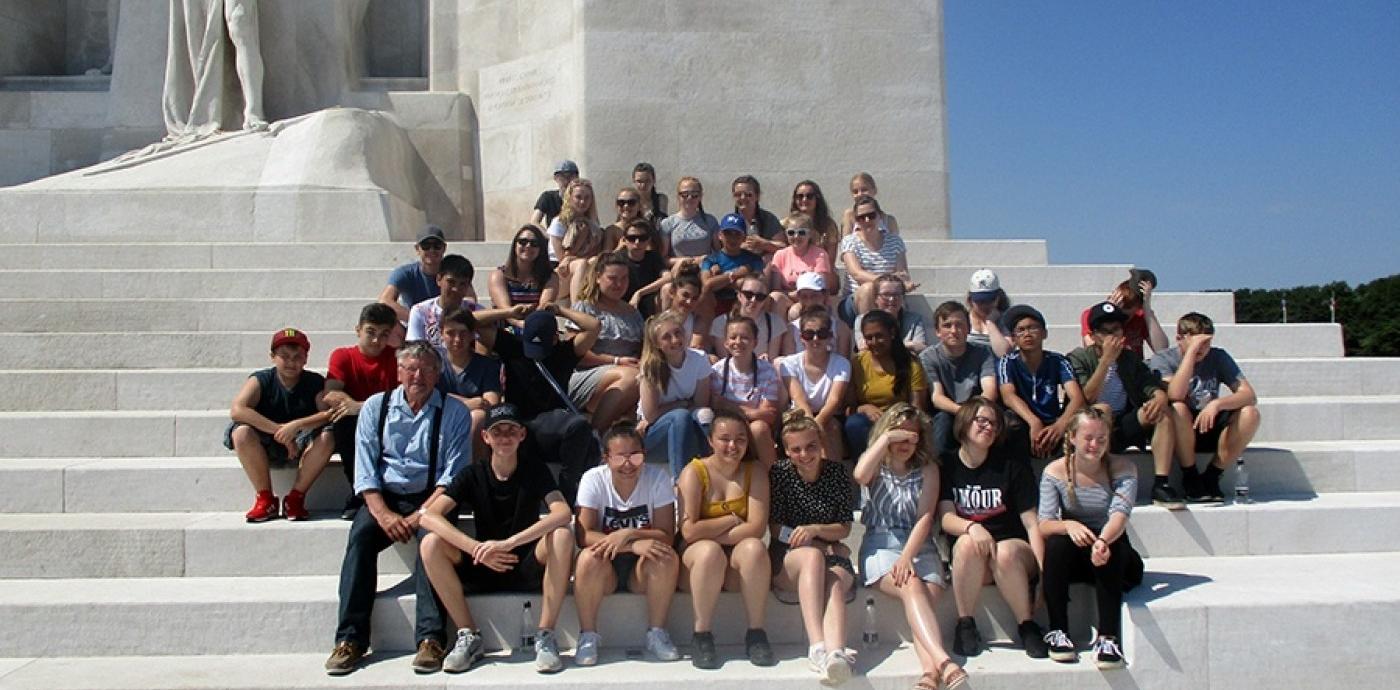WWI tour to the Somme by coach: 3 days, 2 nights
With its historical significance during WWI, this tour to the Somme is a perfect choice to aid students understanding of this period in history. Visits to the memorials and other key sites such as Thiepval Memorial and Museum, will give the students first-hand experience of the conditions and destructiveness of war.
Similar tours
Suggested itinerary

Day one
- Depart from school by coach
- Connect with channel crossing
- Stop en route at Pozières
- Arrive at accommodation

Day two
- Wellington Quarry and Belfry
- Thiepval Memorial & Museum
- Beaumont-Hamel Memorial Park

Day three
- Depart accommodation
- 1916 Somme Museum
- Return to the UK on coach
Tour gallery
Excursion locator map
Excursion Ideas

Ulster Tower, Thiepval
Subject range: Subject range: History WW1
What you’ll experience:
The tower is the memorial both to the 36th division and all Ulstermen who fought in the Great War and is an exact replica of Helen’s Tower, County Down, near the 36th Division’s training ground in Belfast. The monument is located near to the Schwaben Redoubt which the Division attacked on July 1st, 1916.
Select says: A visitor centre is on the site displaying artefacts, including items recovered from the battlefields around the Memorial Tower, and personal items related to the soldiers of the 36th Ulster Division.
Vimy Ridge
Subject range: Subject range: History WW1
What you’ll experience: Vimy Ridge is a the site is maintained as a memorial to the Canadian Forces who fought in the Great War.The successful attack at Vimy Ridge was undertaken by the Canadian Corps on the 9th of April, 1917. The ground in the memorial park has been left undisturbed, and there are trenches and shell holes still visible. In one area, the trench outlines have been made more permanent by the addition of concrete sandbags.
Select says: Due to the strategic importance of this high land high, the trench lines were close together and it is possible to stand in either the German or the Canadian trenches, and see how close the enemy trenches were in this sector from the infantry soldier’s perspective. You can also visit the underground tunnels where the troops lived.
Beaumont-Hamel Newfoundland Memorial Park
Subject range: Subject range: History WW1
What you’ll experience: Located near Beaumont Hamel, this park is one of only a few sites on the Western Front where the ground has remained largely untouched since the end of WWI. The great caribou memorial stands at the highest point of the park, emblem of the Royal Newfoundland Regiment. Something of the terrible problem of advancing over such country can be appreciated by visitors as the actual frontline trenches are still visible. There is also a visitor’s centre featuring a copy of the Newfoundland Book of Remembrance, memorabilia and short video clips.
Select says: Free guided tours are possible but must be pre-arranged.
Somme 1916 museum in Albert
Subject range: Subject range: History WW1
What you’ll experience:Somme 1916 museum is located in a tunnel complex beneath the city that was also used as shelters in WWI. It displays various objects and weapons used in WWI and shows the appearance of new technologies used such as gas and tanks. Fifteen scenes display the trenches and help understand the reality of the French, British and German soldiers during WWI.
Select says:There are excellent educational workbooks available to download from the Somme 1916 Museum website prior to your tour.

Thiepval Memorial to the Missing & Museum
Subject range: Subject range: History WW1
What you’ll experience: The Thiepval Memorial to the Missing of the Somme is a major war memorial to 72,191 missing British and South African men who died in the Battles of the Somme of the Great War between 1915 and 1918 with no known grave. The names of the missing are etched into the memorial along with a large inscription reading ‘Here are recorded names of officers and men of the British Armies who fell on the Somme battlefields between July 1915 and March 1918 but to whom the fortune of war denied the known and honoured burial given to their comrades in death’. The Thiepval Visitor Centre is located a short distance from the Thiepval Memorial and now has a museum with new galleries themed on the battles of the Somme and the memory of lost soldiers. The permanent exhibition presents a large collection of artefacts, archaeological finds, multimedia displays and life-sized installations.
Select says: It is also possible to visit the Thiepval Wood Trenches (accessible by guided tour only), providing insights into life in the trenches as well as the preparation for the attack by the men of Ulster on 1 July 1916. It should be remembered that munitions are still being found and it is important to keep to the designated paths and to touch nothing.
Wellington Quarry
Subject range: Subject range: History WW1
What you’ll experience:The Wellington Quarry is an underground museum created in a section of the many kilometres of tunnels dug by the British Army in WWI. The First World War tunnels connect with original tunnels and quarries dating back to the middle ages and Roman times underneath the city of Arras. A glass-fronted lift takes the visitor into the site which preserves the memory of the thousands of soldiers who were in the underground barracks a few metres from the front before launching a surprise attack on 9th April 1917 at 5:30 am, the Battle of Arras.
Select says:On leaving the tunnels the group is invited into to watch a short and moving film about the Battle of Arras.

Pozières
Subject range: Subject range: History WW1
What you’ll experience: This small village is located on a ridge of high ground between Albert and Bapaume, and thus had great strategic importance. When visiting the Pozières Memorial to the Missing of 1918 it is possible to visit Pozières British Cemetery which is also enclosed within the boundary wall. The memorial comprises the magnificent gateway building with open colonnade walkways forming the eastern boundary walls to the right and left of the gate.
Select says: It is possible for students to search for names on the memorial pre-tour. Please see the Commonwealth War Graves Commission (CWGC) website.
WWI trip to the Somme by coach: 3 days, 2 nights Accommodation

Poppies d' Albert
Location: Albert
Capacity: 120
Ideally situated in the heart of the Somme, a 3 minute walk from Albert town centre. The hotel is also within easy walking distance of a swimming pool and bowling alley.
Rooms: All rooms have en-suite facilities.
Facilities: Breakfast room, free Wi-Fi, lounge area, games room.

Parc d'Olhain
Location: Houdain
Capacity: 96
Houdain is a small historic town situated between Bethune and Arras. This spacious purpose built centre is set in parkland with stunning views just a few kilometres from Houdain. The self-contained site is great for groups looking for a quieter location and with plenty to keep students occupied whilst not out on excursions.
Rooms: Mostly en-suite rooms, some shared facilities.
Facilities: Restaurant, recreation rooms, outdoor pool, tennis court, basketball, volleyball and football.
Links to Learning
Learning areas:
KS3
Challenges for Britain, Europe and the wider world 1901 to the present day
The First World War and the Peace Settlement
A study of a significant society or issue in world history and its interconnections with other world developmentsKS4
Conflict and tension, 1894–1918 (AQA)
The British sector of the Western Front, 1914–18: injuries, treatment and the trenches (Edexcel)
War and British Society c.790 to c.2010 (OCR)
Britain in Peace and War, 1900–1918 (OCR SHP)
The Development of Warfare, c.1250 to the present day (WJEC 2017)
Empire, Reform and War: Britain, 1890-1918 (WJEC 2016)
The Development of Warfare, c.500 to the present day (WJEC 2016)
Historical Study: European and World (SQA)KS5
International Relations and Global Conflict, c1890–1941 (AQA)
Wars and Welfare: Britain in Transition, 1906–1957 (AQA)
The British experience of warfare, c1790–1918 (Edexcel)
The changing nature of warfare, 1859–1991: perception and reality (Edexcel)
Britain 1900–1951 (OCR)
International Relations 1890–1941 (OCR)
The Changing Nature of Warfare 1792–1945 (OCR)
Europe In An Age Of Conflict And Co-Operation c.1890-1991 (WJEC)
Historical Study: European and World (Higher) (SQA)
Clash of Ideologies in Europe 1900–2000 (CEA)
The Causes and Consequences of Great Power Conflict 1848–1945 (CEA)


















